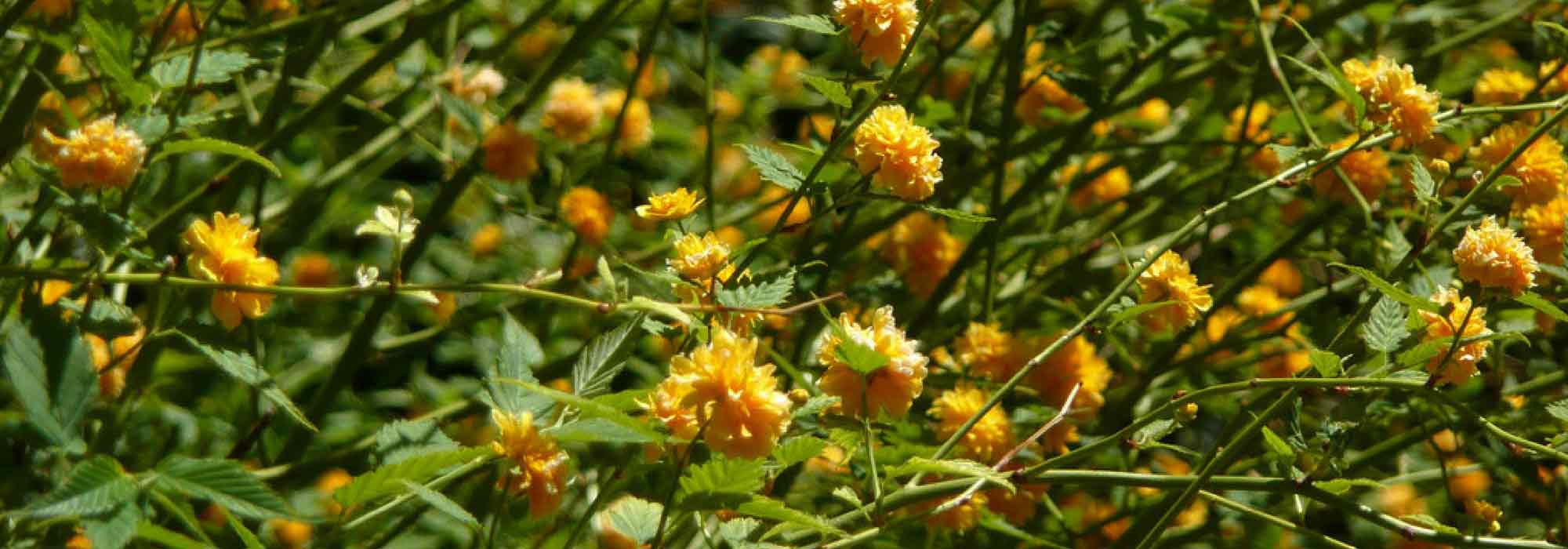
Japanese kerria, Kerria japonica: planting, pruning and care
Contents
Japanese cornel, in a nutshell
- Japanese spiraea offers a generous spring flowering in the form of yellow pom-poms
- It is a beautiful sunny and decorative bush also due to its light foliage
- It settles easily in full sun or partial shade
- Compact and very hardy, it thrives in all gardens
- It can be used in free hedges, in borders, and also in pots
A word from our expert
Kerria or Japanese Rose is a widely spread bush in our gardens, particularly hardy and extremely floriferous from the arrival of spring. From April to May, the bright green foliage is covered with a golden shower of small pompom-like flowers that will attract all eyes.
Its lovely bushy silhouette and moderate size allow for numerous uses in all gardens, even small ones, from the most naturalistic to the wildest.
Today, there are some interesting cultivars, including the essential, Kerria Japonica ‘Pleniflora’. However, despite hybridization efforts, there is still no pink Japanese Rose, and it remains a bush with yellow flowering!
It establishes itself so easily by suckering on the ground that some may find the Japanese Rose a tad invasive… But the vigour of this beautiful bush is matched only by its floribundity and its hardiness against all odds!
Whether planted as a solitary specimen, in a flowering hedge or free-form, in a pot or in a bed, this bush is very hardy down to -25°C and will reveal its splendour in the heart of spring. Robust, disease-resistant and very easy to grow, the Japanese Rose thrives in full sun or partial shade and grows anywhere, in a cool, fertile, and well-drained soil, sheltered from the wind.
With its sparkling flowering, its light and elegant foliage in summer, its branches that remain green even after leaf fall, it is an ornamental sunny bush in every season.
Robust, space-saving and very tolerant of urban pollution, discover how to take a cutting of Japanese Rose or when to prune this essential bush for spring scenes.
Description and Botany
Botanical data
- Latin name Kerria japonica
- Family Rosaceae
- Common name Japanese Kerria
- Flowering from April to June
- Height 1.50 to 3 m
- Exposure Sun, partial shade
- Soil type Neutral, acidic, well-drained
- Hardiness -25°
Kerria or Japanese Kerria is a flowering bush, the only species of the genus Kerria. Belonging to the large family of Rosaceae, it grows in the clear forests and copses of China and Japan where it has since naturalised.
The type species kerria japonica, which is hardly cultivated anymore, has given rise to some interesting cultivars including ‘Pleniflora’, the most widespread, ‘Golden Guinea’ and ‘Picta’.
Fast-growing, Kerria quickly forms an elegant bush with few branches, with an upright, somewhat unruly habit, featuring arched branches that remain green, tending to spread with age and under the weight of the flowers. It rarely exceeds 2 to 3 metres in height with a width of 2.50m.
The Japanese Kerria easily establishes by suckering on the ground; at best this will give the bush a good ground cover at maturity, at worst it will make it somewhat invasive. With an average lifespan, it lives on average 10 to 15 years.
Kerria boasts one of the most beautiful spring flowerings. From April to June, a profusion of numerous small golden-yellow flowers 2 to 6 cm in diameter cover the bush in a golden rain. They appear singly along the soft green stems. While the type species and most varieties like ‘Golden Guinea’ have large single flowers resembling small lemon-yellow roses, Kerria japonica ‘Pleniflora’ bears double flowers, resembling silky orange pom-poms. This flowering is sometimes modestly perpetual at the end of summer.
In a vase, cut branches covered in flowers create fresh and vibrant bouquets.

Evolution of a flower of Kerria japonica ‘Pleniflora’.
This beautiful bush, particularly floriferous, is also decorative for its light foliage which serves as a backdrop to this dazzling yellow flowering. Along with the flowers, deciduous leaves 6 to 10 cm long appear. Oval in shape, they are alternate, simple, finely dentate and end in a pointed tip. Bright green to light green, sometimes grey-green, they are sometimes marginate with cream white, depending on the varieties.
After the leaves fall, the bush, whose branches remain green throughout winter, retains a certain ornamental interest.
Hardy down to -25 °C, particularly resistant to pollution, the Japanese Kerria is easy to cultivate. Not demanding, it grows in all climates, in full sun or light shade, in any soil even calcareous or slightly acidic, rich, cool, light and well-drained.
With its bushy silhouette, modest size and bright flowering, the Japanese Kerria finds its place in all gardens, whether large or small. It works wonders in free hedges or shrub borders or in isolation. It also performs very well in pots and makes a beautiful trellis along walls.
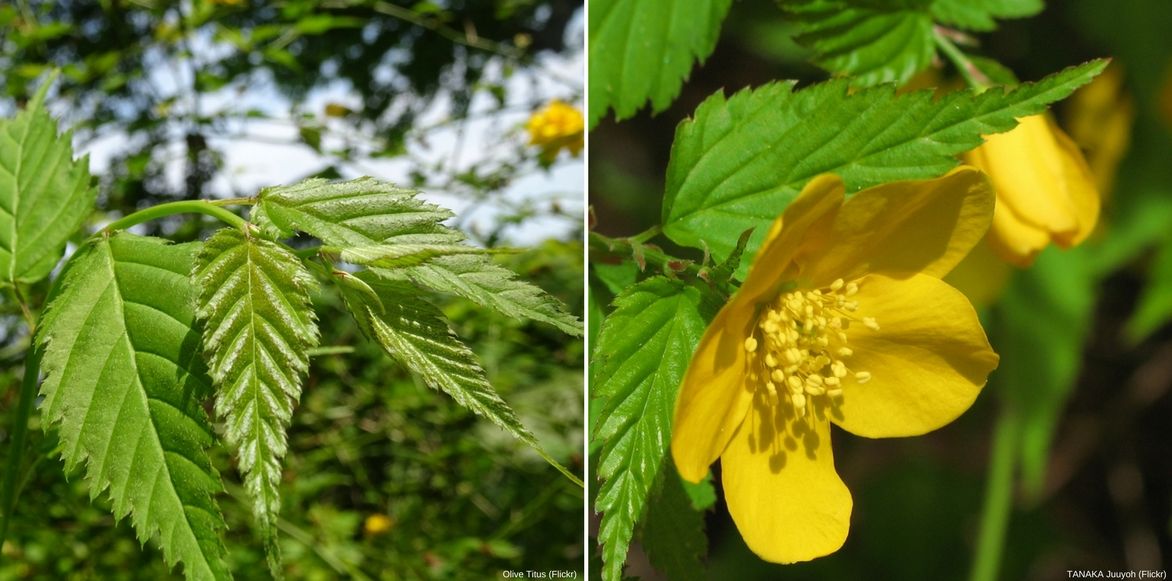
From left to right: light and finely dentate foliage / single flower of a Kerria japonica ‘Golden Guinea’.
Main species and varieties
The genus includes only one species Kerria japonica, which is hardly cultivated anymore; it has given rise to some interesting cultivars, widely found in our gardens such as ‘Pleniflora’ with double flowers forming lovely orange pompons, ‘Golden Guinea’ with large single flowers of golden yellow, or ‘Picta’ with grey-green variegated foliage. All are very hardy, easy to grow, and form a beautiful bush remarkably floriferous.
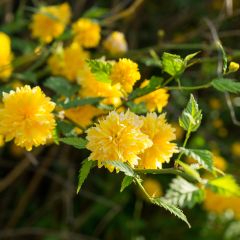
Kerria japonica Pleniflora - Japanese Rose
- Flowering time May, June
- Height at maturity 2 m

Kerria japonica Pleniflora - Japanese Rose
- Flowering time May, June
- Height at maturity 2 m
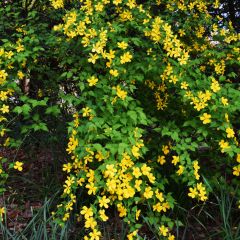
Kerria japonica Golden Guinea - Japanese Rose
- Flowering time May, June
- Height at maturity 2 m
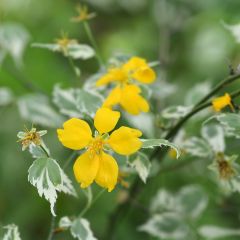
Kerria japonica Picta - Japanese Rose
- Flowering time May, June
- Height at maturity 1,50 m
Discover other Kerrias
View all →Available in 0 sizes
Available in 1 sizes
Available in 2 sizes
Available in 1 sizes
Available in 1 sizes
Planting
Where to Plant Japanese Kerria
Japanese Kerria grows all over France, except perhaps in Mediterranean climates, which can be too hot and dry in summer. Remarkably hardy, it can withstand very low temperatures down to -25 °C, sometimes even lower, making it perfectly resilient in all regions.
It should preferably be planted sheltered from strong winds, to protect its arching stems, especially when they bend under the weight of the flowers.
It is preferably planted in full sun where it flowers better, although it will tolerate partial shade, especially in warmer regions. Too dense shade would result in a somewhat less showy flowering.
Not very demanding, it appreciates well-drained, humus-bearing soil that remains cool in summer: avoid overly dry soils as well as waterlogged soils in winter.
Kerria japonica is a compact shrub that adapts to all gardens. It can be combined with other fast-growing plants to create an instant garden; it quickly forms a beautiful bush of greenery, rarely exceeding 2.5 m in height and almost the same in width.
However, ensure it has a suitable location: it suckers vigorously, sometimes to the point of smothering its neighbours.
Its resistance to urban pollution makes it essential in city gardens. It can be used as a free-flowing, flowering hedge, in the background of a perennial bed or in a grove of spring-flowering shrubs, trained against a wall or trellis, as a solitary feature on a lawn, and even in a large pot on a terrace in non-scorching sun.
When to Plant
The Kerria japonica is preferably planted in autumn from November to February to encourage rooting before winter, avoiding frost periods. Potted specimens can be planted in spring, provided regular watering is ensured during the first year after planting.
How to Plant
In the Ground
Kerria prefers fertile and well-drained soils where water does not stagnate, especially in winter.
For hedges, space the plants about 80 cm apart.
- Soak the root ball in a basin of water
- Dig a hole twice as wide and deep as the root ball
- Enrich the extracted soil with half a bucket of well-matured compost
- Plant the shrub at the centre of the hole
- Backfill while keeping the shrub upright and firm the soil
- Mulch to keep the base clean and cool during summer
- Water lightly at planting, then once or twice a week during growth in the first year after planting
- Japanese Kerria in a Pot
It is possible to grow Japanese Kerria in a pot in a sufficiently large container (at least 90 cm in diameter). The substrate must be well-drained to avoid stagnant moisture at the roots. Repot every 2 to 3 years.
- Spread a good layer of drainage (gravel or clay balls)
- Plant in good shrub compost mixed with one or two handfuls of compost
- Mulch the base
- Water well during the growing season and whenever the soil is dry
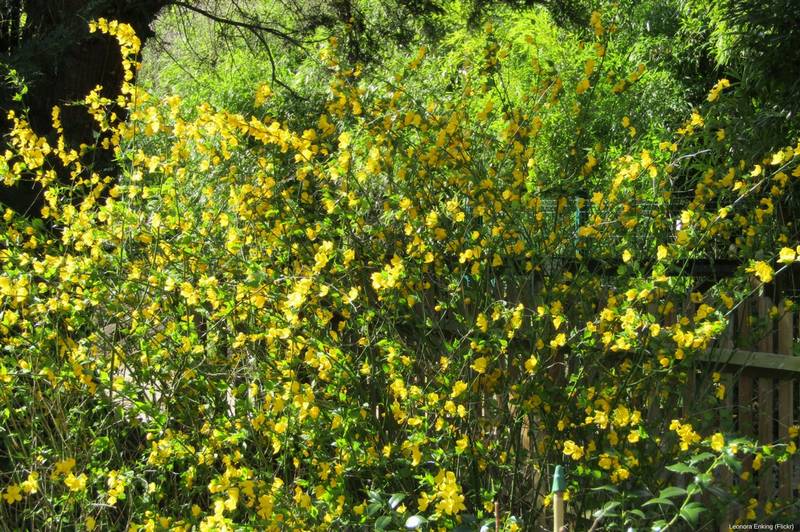
Care
The Japanese kerria requires very limited maintenance. It prefers cool, not too dry soils. In summer, water once or twice a week during hot weather. To keep the base cool during the warm season, apply a good layer of organic mulch before spring, especially in the first few years after planting.
Remove the numerous suckers that appear around the stump as they arise.
For potted kerrias: keep the substrate consistently moist.
An annual application of compost at the base each autumn improves its growth and encourages its flowering.
How and when to prune the Japanese Quince?
When to prune Japanese Kerria?
Pruning is carried out annually, after flowering, in June. This pruning helps to thin the branches to avoid a too-bushy appearance, discipline its branches and maintain a compact habit, encourage vigorous regrowth and abundant and regular new flowering: over time, the bush tends to become bare in the centre and only flowers at the tips. Depending on the pruning carried out, it may modestly flower again in late summer and autumn.
How to prune?
- Prune about 1/3 of the deflowered shoots from the current year at the base above a large bud located at the base of the stem
- Prune to the ground the old wood, dead, thin or tangled stems, ensuring that light can penetrate well into the heart of the branches.
→ Learn more in our tutorial: How to prune Japanese Kerria?
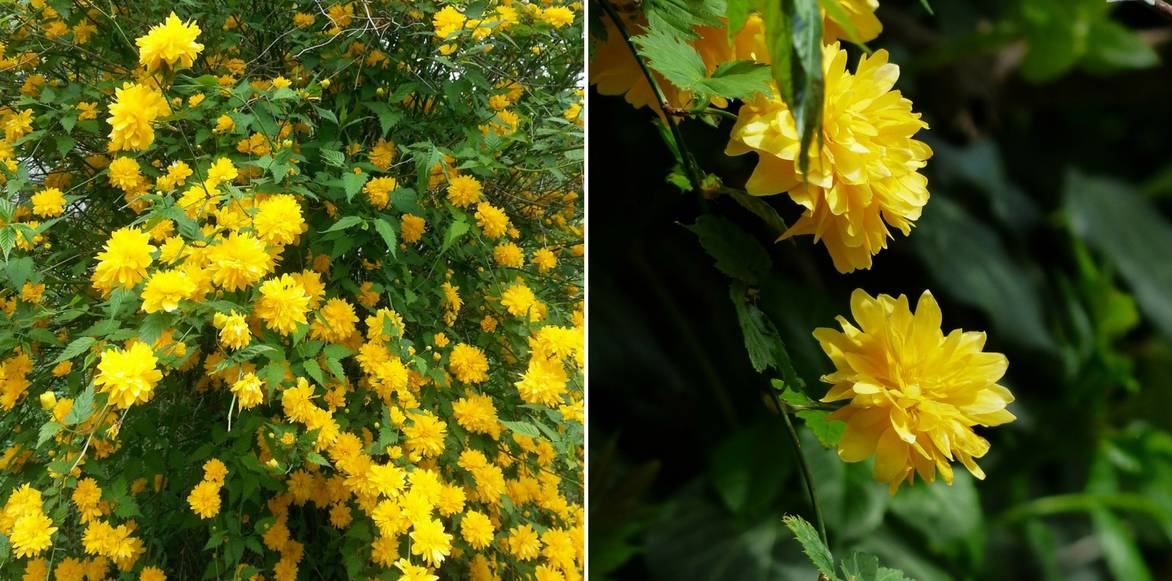
Diseases and potential pests
Japanese cornels are generally not prone to diseases or pest attacks.
However, a report was sent to the Royal Horticultural Society in 2014. Indeed, some gardeners across the Channel reported damage in the form of reddish-brown spots, lesions on the stems, as well as defoliation that could lead to the death of the bush. According to the study of samples, this infection is caused by a specific fungus, Blumeriella kerriae, whose proliferation is favoured by humid weather conditions.
We advise you to cut away all affected plant material and burn it to kill the fungal spores. The fungus overwinters in fallen leaves and stem lesions. Also, consider gathering fallen leaves to limit the inoculum the following year.
Propagating
By separating suckers
The Japanese Kerria tends to sucker naturally: it easily multiplies by separating the young rooted suckers around the edge of the clump. They will flower the following spring.
- In October, using a spade, lift a clump of soil with a rootstock and roots, then take several suckers
- Immediately replant the rootstock pieces in well-worked light soil in the garden
How to propagate roots of Kerria japonica
- In autumn or winter after flowering, take surface roots with buds
- Cut the roots into sections of 4 to 10 cm, ensuring each has one or more buds
- Place clay balls at the bottom of a tray filled with a light potting mix
- Plant the cuttings and cover with 2 cm of potting mix
- Place the tray in an unheated room.
- Plant out as soon as the cuttings are sufficiently rooted
Associaing Kerria japonica
Queen of spring scenes, the Japanese Kerria is remarkable for the profusion of golden yellow flowers it offers in spring. Unobtrusive and easy to care for, it has its place in all natural and wild gardens. Whether planted alone, against a wall, on a short grass meadow, in a border or as a free-standing hedge, it pairs well with a multitude of plants, bulbs, and other spring-flowering bushes for wonderfully vibrant monochrome scenes, bucolic chic in white and gold or contrasting gold/blue.
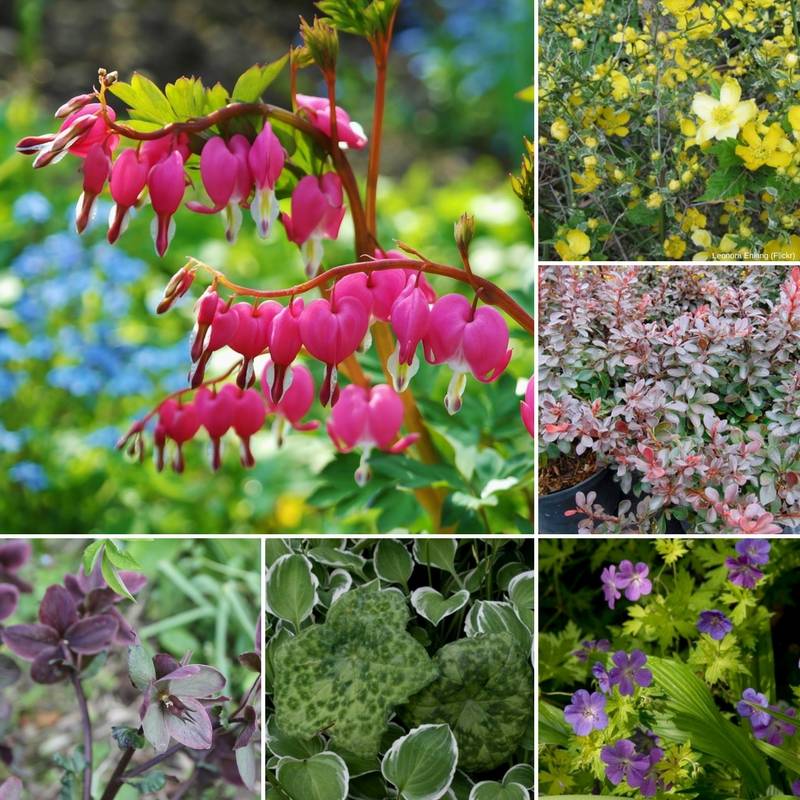
A spring association idea: Dicentra spectabilis, Kerria japonica ‘Picta’, Berberis thunbergii ‘Atropurpurea Nana’, faded but no less decorative flowers of Helleborus orientalis, Podophyllum ‘Spotty Dotty’ and Hosta ‘Silver Crown’, Geranium ‘Blue Sunrise’.
Its sunny flowering will accompany the simultaneous blooming of Forsythias, broom, a Laburnum ‘Golden Rain’, and a Magnolia ‘Daphne’ with canary yellow flowers. It can be paired with plants that have mauve or blue flowers such as lilac, althea, buddleias, blue hydrangeas, and abelia, which will elegantly contrast with its yellow flowers.
The kerria can also be associated with large delphiniums that require the same growing conditions.
In a free-standing and flowering hedge, it will be the perfect companion to shrubs that bloom earlier or later in the season, extending the display, such as flowering currants, spiraea, deutzia, and weigelia.
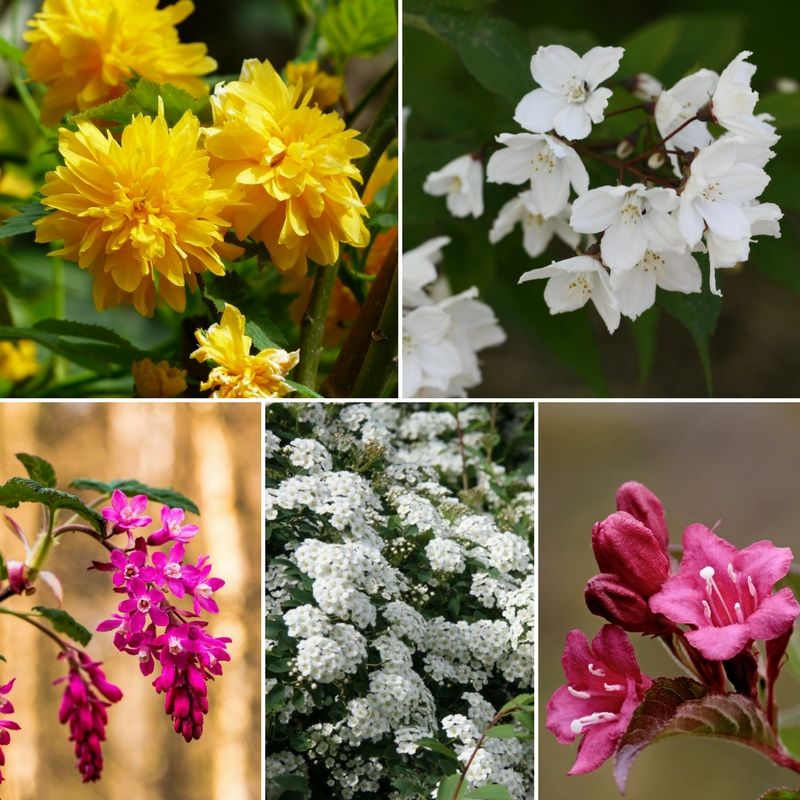
An example of a free-standing hedge association: Kerria japonica ‘Pleniflora’, Deutzia rosea ‘Campanulata’, Ribes sanguineum ‘King Edward VII’, Spirea nipponica ‘Snowmound’, Weigelia ‘Bristol Ruby’.
In a border, pair it with shrubs that have decorative foliage to enhance the garden after the flowers have faded, such as Elaeagnus ebbingei ‘Eleador’ with its magnificent variegated leaves or Kolkwitzia amabilis ‘Maradco’ or Beauty Bush with its lovely bright yellow leaves.
Dare to combine it with a Malus Golden Hornet, a Choisya ternata, a viburnum plicatum, and a comfrey for a contrasting play of shapes.
Its branches, dotted with small golden yellow flowers, will serve as a backdrop for early-flowering euphorbias, bulbs such as yellow daffodils, fritillaries, steppe lilies, or tulips, and will stand out powerfully in compositions with vibrant colours, bringing cheerfulness and brightness to the garden.
After the leaves have fallen, its arching branches remain green, making a striking display alongside a Cornus stolonifera ‘Flaviramea’, recognisable by its bright yellow wood in winter, and will add colour to your garden when other plants are in dormancy.
→ Discover more association ideas with Kerria japonica or Japanese Kerria in our advice sheet!
Useful resources
- The most beautiful Kerrias are with us!
- Discover 7 bushes with yellow flowers
Frequently asked questions
-
I have a Japanese corête that is drying out, what is happening?
Like all trees and bushes in the Rosaceae family, Kerria can, particularly in certain regions, fall victim to fire blight: the leaves, floral clusters, and affected shoots appear burnt, the bush wilts suddenly and dies within a few weeks. There is no truly effective treatment. For prevention: in March-April, spray a horsetail decoction. In case of an attack: first remove and burn the spotted leaves and affected shoots. Uproot and burn the plant if the disease is too widespread.
- Subscribe!
- Contents































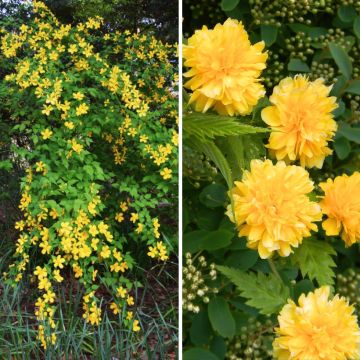



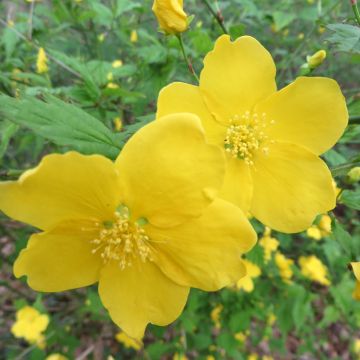
Comments